Welcome to our blog. A space dedicated to helping you improve your daily life, personal lifestyle, Tools, personal finance, and keeping updated with current trends.
Here are some of our popular posts: Top 10 best website builders, Best super foods for a healthy lifestyle, the unlimited list of free productivity apps, Best freelance site to find remote jobs, top 10 productivity hacks for entrepreneurs , 10 best side hustles to make extra money online, best online courses for learning digital skills, top 10 best free coding website
The marketplace has evolved rapidly, and businesses in 2025 are no longer relying solely on traditional sales and marketing tactics. Artificial Intelligence has transformed how companies attract, engage, and convert customers. From automating lead generation to personalizing customer journeys, AI tools now play a crucial role in building effective sales funnels that not only increase revenue but also optimize every stage of the buyer experience.
If you want to stay ahead in the market, understanding how to build a Sales Funnel with AI Tools is essential. This article provides a detailed and practical guide on how to design, automate, and optimize your entire sales funnel using AI-powered solutions. You will learn how AI can help you reach the right audience, create smart automation, nurture leads, and convert visitors into loyal customers.
What Is a Sales Funnel and Why Does It Matter
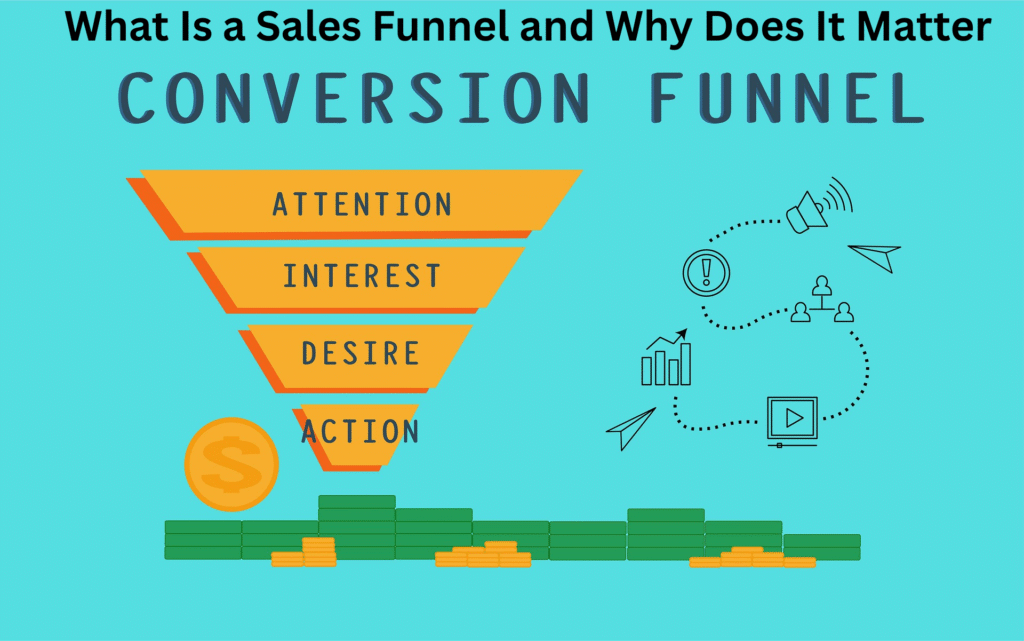
Before diving into how to build a Sales Funnel with AI Tools, it is important to understand what a sales funnel is. A sales funnel is a visual representation of the customer journey, from the moment a person discovers your brand to the point they make a purchase or take a desired action. The funnel is divided into stages: awareness, interest, decision, and action.
In traditional marketing, creating an effective sales funnel required manual effort. You had to attract traffic, capture leads, send follow-up emails, and analyze performance, often with limited data. Today, AI tools can automate and enhance every part of that process. They can predict customer behavior, personalize interactions, and analyze massive data sets to identify what truly converts.
A well-structured sales funnel helps businesses achieve three main goals. First, it guides potential customers through a clear journey instead of leaving them to figure things out. Second, it ensures consistency in how you handle leads and prospects. Third, it maximizes conversion rates by nurturing relationships and providing value at every step.
How AI Transforms the Modern Sales Funnel
Artificial Intelligence has revolutionized sales and marketing by providing smarter, faster, and more accurate ways to engage with customers. AI tools use machine learning, natural language processing, and predictive analytics to automate repetitive tasks, gain insights from customer data, and improve decision-making.
When you build a Sales Funnel with AI Tools, you combine technology and strategy to achieve efficiency and precision. AI tools can segment audiences automatically, recommend personalized content, optimize landing pages, and even handle customer communication through chatbots.
For example, AI-powered email marketing platforms can analyze open rates and predict the best times to send messages. AI chatbots can answer common customer questions instantly, while predictive analytics tools can identify which leads are most likely to convert. The result is a funnel that continuously learns and improves itself.
In 2025, businesses that leverage AI in their sales funnels can achieve up to 40 percent higher conversion rates than those using traditional methods, according to recent marketing automation studies
Top 10 Best AI Tools for Building a Sales Funnel
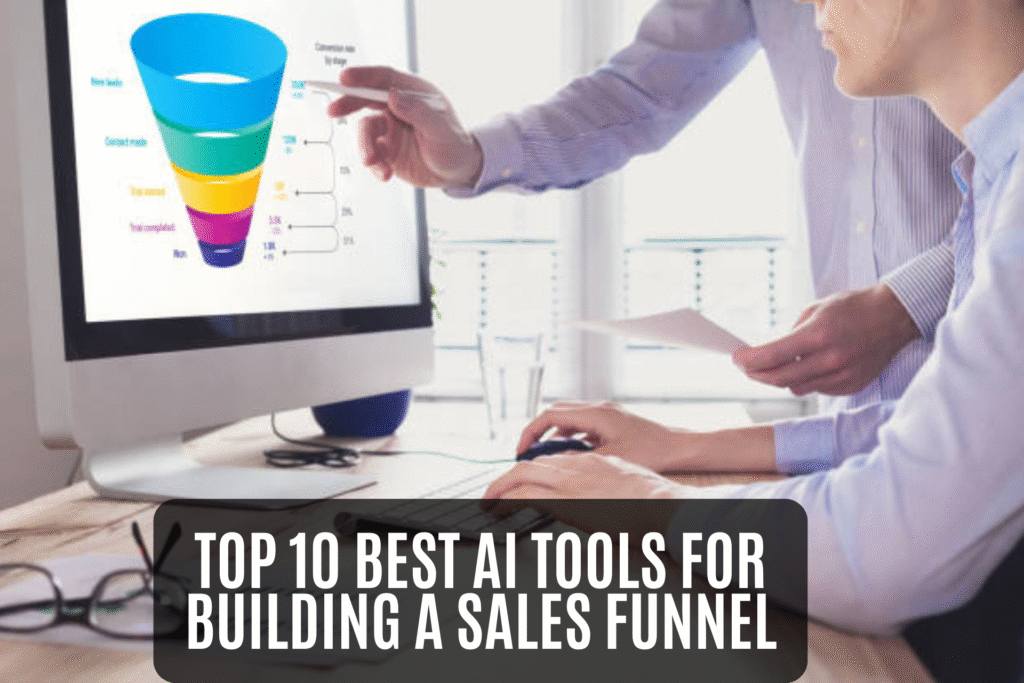
If you’re aiming to build a sales funnel with AI tools in 2025, these ten platforms represent some of the most capable options across different stages of the funnel. Each tool has strengths that depend on where your business currently needs the most improvement. The key is to choose tools that align with your funnel bottlenecks, integrate with your workflow, and enable you to provide personalized, automated, data-driven engagement.
HubSpot Sales Hub now incorporates AI-driven features for predictive lead scoring, workflow automation, chatbot engagement, and content optimisation. When you build a sales funnel with AI tools, having an integrated CRM and automation backbone means you can capture leads, segment them intelligently, and trigger appropriate follow-ups without a lot of manual work. HubSpot’s strength is in combining marketing and sales funnel stages from lead capture through conversion in one platform.
#2. Salesforce Einstein
Salesforce Einstein embeds AI into the widely used Salesforce CRM, offering deal scoring, next-best-action recommendations, and forecasting. For building a sales funnel with AI tools, Einstein gives you strong insights at the decision and action stages of the funnel, which leads to prioritise what outreach to do and when to engage. Good for businesses with large sales operations.
#3. Apollo.io
This tool focuses on prospecting and outbound engagement using AI for data enrichment, intent signals, and automated outreach sequences. When you build a sales funnel with AI tools, the top of the funnel (awareness, interest) is critical: Apollo.io helps you fill the funnel with qualified leads, not just random contacts, which improves overall efficiency.
#4. Gong.io
Gong uses AI-driven conversation intelligence to analyse sales calls, meetings, and emails. It surfaces patterns, risk signals, and best practices. In a funnel built with AI tools, this kind of insight helps you optimise the mid-funnel (decision stage) by knowing what works, what doesn’t, and improving your content or messaging accordingly.
#5. Drift
Drift specialises in conversational AI and chatbots that engage website visitors in real time, qualify leads, and schedule meetings or hand off to human agents. When you build a sales funnel with AI tools, using a smart chatbot means you don’t lose visitors at the landing page stage: you engage them immediately, capture information, and move them into the funnel efficiently.
#6. GetResponse
GetResponse offers AI-driven email marketing automation, list segmentation, and behavioural tracking to trigger campaigns based on user action. In the funnel-with-AI-tools context, this is crucial for the nurture stage: once you’ve captured leads, you need to move them toward conversion with timely, personalised messaging.
#7. AdCreative.ai
AdCreative.ai generates ad visuals and copy using AI, optimised for high conversion and engagement. When building a sales funnel with AI tools, your awareness and interest stages depend on attracting the right people with compelling creative. A tool like this helps you produce ad assets faster and test them more efficiently.
#8. Clay
Clay is described as a prospecting engine that combines AI-powered enrichment, data aggregation and personalisation of outreach. In a funnel built with AI tools, this means you can feed your funnel with high-quality leads, tailor your messaging, and maintain relevance—improving conversion rates.
#9. Systeme.io
Systeme.io is an all-in-one funnel builder that, when combined with its AI features, enables landing page creation, email sequences, and automation in one place. When you build a sales funnel with AI tools, having an integrated funnel builder simplifies many moving parts (traffic, capture, nurture, conversion) and allows you to manage it from one platform rather than stitching multiple tools together.
#10. ManyChat
ManyChat focuses on conversational marketing on messaging platforms (like WhatsApp, Instagram, Facebook Messenger) using AI chatbots to engage, qualify, and convert. When you build a sales funnel with AI tools, especially if you’re working in markets where messengers are popular (which is true in many parts of Africa, Asia, and Latin America), this kind of tool gives you an extra channel to capture interest and move prospects into your funnel.
Step-by-Step Guide: How to Build a Sales Funnel with AI Tools
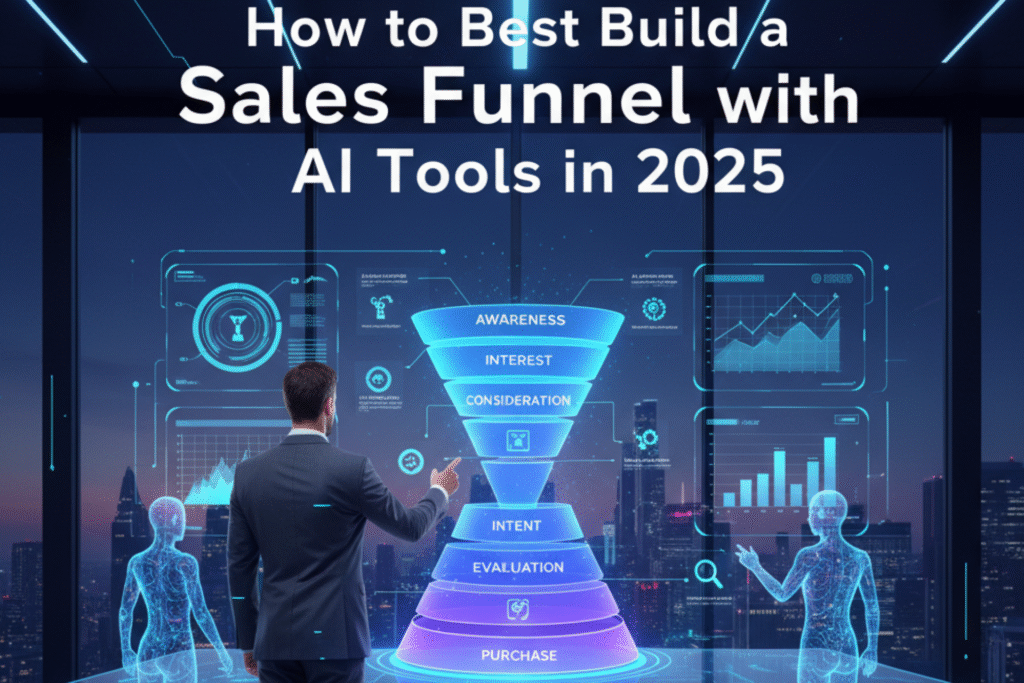
Let us walk through the practical steps you can follow to build a Sales Funnel with AI Tools. Each stage of the funnel can be powered by different AI-driven platforms and techniques that improve performance and reduce manual workload.
Step 1: Define Your Target Audience Using AI Analytics
The first step in any sales funnel is understanding who your customers are. In the past, this meant manually analyzing demographics and guessing audience behavior. Today, AI analytics tools can collect and interpret data from multiple sources such as websites, social media, and customer databases.
Tools like Google Analytics 4, HubSpot AI Insights, and IBM Watson Analytics help you understand your audience’s interests, pain points, and purchase behaviors. AI can segment your audience into groups based on intent, spending habits, and engagement level.
This means you no longer waste resources targeting the wrong people. Instead, you can tailor your campaigns to attract potential buyers who are more likely to convert.
Step 2: Use AI to Attract Traffic
The next step is driving traffic to your sales funnel. AI tools are powerful allies in digital advertising and content marketing. Platforms like Meta Ads Manager, Google Ads AI, and Jasper AI can optimize ad performance automatically. They analyze your data to determine the best headlines, visuals, and copy that resonate with your audience.
Search Engine Optimization has also become smarter. AI-powered SEO tools such as SurferSEO, Clearscope, and MarketMuse can recommend keywords, analyze competitor content, and predict which topics will perform best. This ensures your blog posts, landing pages, and social media campaigns are optimized for visibility and engagement.
By using AI to attract traffic, you not only save time but also ensure that the right visitors are entering your funnel.
Step 3: Capture Leads with Intelligent Forms and Chatbots
Once you have traffic coming to your website or landing page, the next task is to capture leads. AI tools can help you do this more efficiently than ever.
AI-powered chatbots such as ManyChat, Intercom, and Drift engage visitors in real time. They can answer questions, collect email addresses, and guide users toward offers or downloads. Unlike static forms, chatbots create conversational experiences that make visitors more comfortable sharing their information.
You can also use AI-enhanced forms that adapt dynamically to user behavior. For example, Typeform and HubSpot Smart Forms adjust questions based on previous responses, making the experience more personalized and increasing completion rates.
Step 4: Nurture Leads with AI-Powered Email Automation
The lead nurturing stage is where many businesses lose momentum. Sending generic follow-up emails no longer works. Today’s customers expect personalization, and AI makes this easy to achieve.
Email marketing tools like ActiveCampaign, Klaviyo, and Mailchimp AI analyze customer engagement data to send the right messages at the right time. They can automatically segment your subscribers, personalize subject lines, and even write email copy using AI-powered text generation.
AI can also predict which leads are ready to buy and which need more nurturing. This means you can focus on warm leads and avoid wasting time on unqualified prospects.
Personalized nurturing through AI builds trust and keeps your brand at the top of your customers’ minds throughout their buying journey.
Step 5: Convert Leads with Smart Landing Pages and Predictive Recommendations
Conversion is the goal of every sales funnel, and this is where AI truly shines. AI-driven landing page builders such as Unbounce Smart Builder and Instapage AI can test thousands of design variations to find the most effective version. They analyze visitor behavior, adjust page elements, and improve conversions in real time.
Additionally, AI recommendation engines like those used by Amazon and Shopify can personalize offers based on user data. For example, if a visitor viewed certain products, AI can recommend similar items or display a limited-time offer to encourage action.
AI-based predictive scoring also helps sales teams identify high-potential leads. Tools like Salesforce Einstein and Zoho CRM AI prioritize leads that are more likely to convert, allowing teams to focus their efforts where they matter most.
Step 6: Retain and Upsell with AI Personalization
The sales funnel does not end at conversion. Retaining customers and encouraging repeat purchases are just as important. AI tools are perfect for post-purchase engagement.
AI systems like Pipedrive AI and Customer.io analyze past purchases and predict future buying behavior. They can automatically send tailored offers or reminders to customers at the perfect time.
Chatbots can provide post-sale support, while AI-driven loyalty programs can reward customer engagement. For instance, an AI system might recommend upgrades or related products based on individual preferences.
By maintaining consistent AI-powered communication, businesses build stronger relationships and turn one-time buyers into loyal customers.
Step 7: Analyze and Optimize with AI Insights
The final step in building a successful funnel is tracking performance and improving continuously. AI analytics tools help you monitor key performance indicators such as click-through rates, conversion rates, and customer lifetime value.
Platforms like Google Analytics 4, Hotjar AI Insights, and Tableau AI visualize data and uncover trends that humans might overlook. They can identify weak points in the funnel and suggest data-driven improvements.
AI even allows predictive forecasting. By analyzing past patterns, the system can predict future outcomes and recommend adjustments to maximize conversions.
Continuous optimization powered by AI ensures your sales funnel remains efficient and competitive in the evolving digital marketplace.
Benefits of Using AI to Build a Sales Funnel
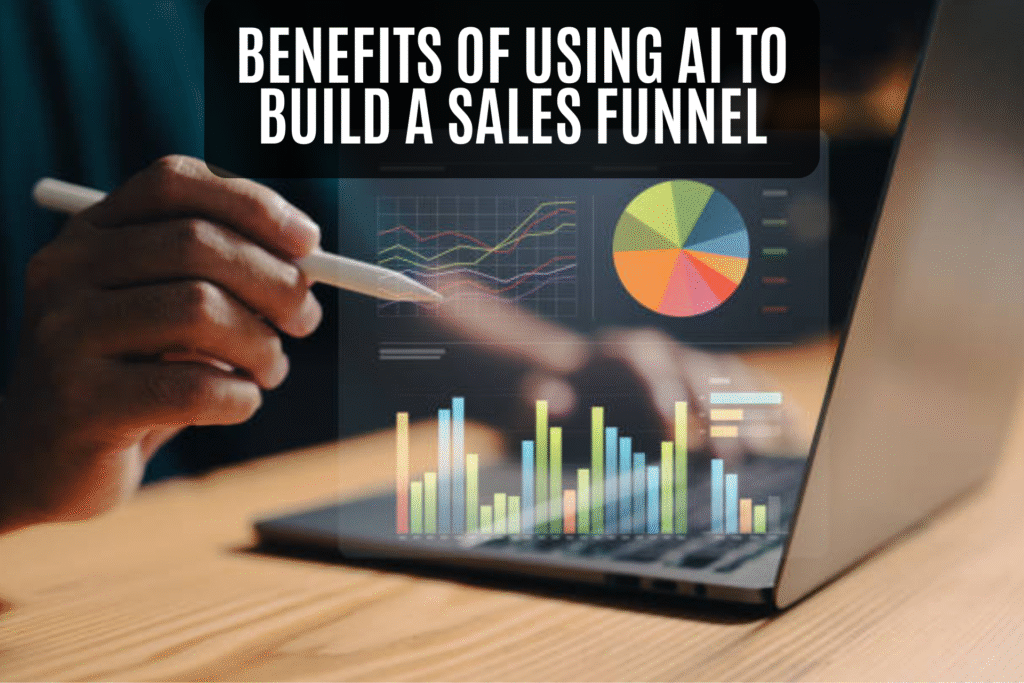
The benefits of using AI tools to build a sales funnel go far beyond automation. One of the most significant advantages is improved personalization. AI enables marketers to tailor experiences for each user, increasing engagement and satisfaction.
Another benefit is cost efficiency. By automating repetitive tasks such as data entry, follow-ups, and analytics, AI reduces operational costs and allows your team to focus on strategy and creativity.
AI also increases speed and accuracy. Instead of manually testing campaigns or guessing what works, AI instantly analyzes data and implements the best-performing options.
AI enhances scalability. Once your system is set up, it can handle thousands of leads simultaneously without compromising quality. This makes AI-driven funnels ideal for small businesses and large enterprises alike.
Finally, AI helps eliminate human bias by relying on data-driven insights. Decisions about marketing, pricing, and communication are made based on real-time analytics rather than assumptions.
Common Mistakes to Avoid When Using AI for Sales Funnels
While AI tools are powerful, they are not magic solutions. Many businesses make mistakes that limit their success. The first mistake is relying completely on automation without human oversight. AI can analyze data, but it still requires human creativity and emotional intelligence to craft compelling messages.
Another mistake is using too many tools at once. Businesses often subscribe to several AI platforms that perform similar tasks, leading to confusion and inefficiency. It is better to start with a few integrated tools that align with your goals.
Neglecting data privacy is another pitfall. Customers in 2025 are more concerned about data security. Always ensure that your AI tools comply with data protection regulations like GDPR and the Nigerian Data Protection Act (NDPA).
Lastly, some marketers fail to update their AI systems. Just like any technology, AI tools need regular updates and optimization to stay effective.
Future Trends: The Evolution of AI Sales Funnels in 2025 and Beyond
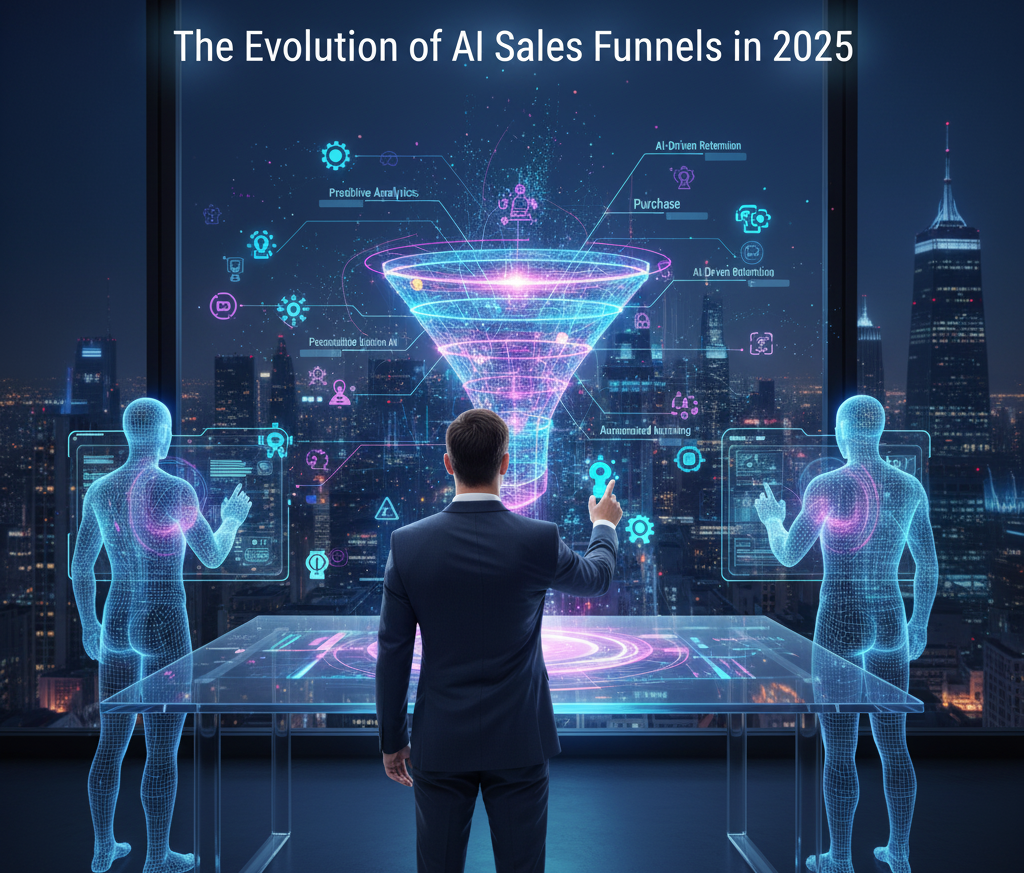
As technology advances, AI-driven sales funnels will continue to evolve. We are already seeing the rise of voice-enabled marketing funnels powered by AI assistants like Alexa and Google Assistant. These allow customers to make purchases using voice commands, expanding the funnel beyond traditional websites.
Hyper-personalization is another major trend. In 2025, AI tools will be capable of analyzing emotional responses and engagement patterns to deliver content that feels almost human. This means your customers will receive messages that reflect their mood, preferences, and past interactions.
Predictive commerce is also on the rise. AI systems can now anticipate customer needs before they even express them, suggesting products or services that match their lifestyle. This proactive approach will redefine the customer journey in the next few years.
Finally, the integration of AI with augmented reality and virtual reality is expected to reshape online shopping experiences. Customers will interact with 3D product demos and AI-guided tours before purchasing, creating a seamless blend of engagement and conversion.
Conclusion: How to Build a Sales Funnel with AI Tools
Learning how to build a Sales Funnel with AI Tools is no longer optional in 2025. It is a necessity for any business that wants to thrive in a data-driven economy. Artificial Intelligence has simplified the process of attracting leads, nurturing relationships, and converting prospects into paying customers.
Here are some of our popular posts: Top 10 best website builders, Best super foods for a healthy lifestyle, the unlimited list of free productivity apps, Best freelance site to find remote jobs, top 10 productivity hacks for entrepreneurs , 10 best side hustles to make extra money online, best online courses for learning digital skills, top 10 best free coding website
By combining human creativity with AI automation, you can create a sales funnel that not only generates revenue but also delivers personalized experiences your audience will love.
The future of marketing belongs to those who can balance technology and strategy. If you take the time to understand and implement AI tools correctly, your sales funnel will become more intelligent, efficient, and profitable than ever before.
So, if you have been asking how to build a Sales Funnel with AI Tools, now is the perfect time to start. Embrace innovation, automate smartly, and let data guide your decisions. With AI by your side, your business will not just grow; it will thrive in 2025 and beyond.


